[ad_1]
The Portland Japanese Garden
In the city of Portland, Oregon there is a world-famous Japanese Maple tree, located just inside the gates of the Portland Japanese Garden just waiting to capture your spirit and imagination. Millions of visitors each year travel to the Pacific Northwest, to the city of roses, to explore everything that this city has to offer including the world renowned Japanese garden.
In 1958, Portland became a sister city to Sapporo, Japan, helping to create a broad interest in Japanese culture. Soon after, several business leaders and the Mayor of Portland decided it would be wonderful for Portland to have a traditional Japanese Garden. On June 4th, 1962, the City Council created a commission to establish the garden on the site of the former Washington Park Zoo.

The Legendary Lace Leaf Maple Tree
This beautiful Japanese Maple tree that so many have grown to love, was not an original planting in the garden. No one is 100% sure of exactly when it was planted, or where it came from. Speaking to Adam Hart, Senior Gardener of the garden, after looking through historical photographs, I was told that this lace-leaf maple was most likely planted sometime around 1971 and is between 65-70 years old.
Every year, when the carefully pruned leaves of the trees & shrubs in the garden shift from the greens of summer to the reds, oranges and golds of autumn, photographers from around the world flock to the garden to capture the transformation of fall and often, specifically to photograph this single lace leaf maple.
Maybe you yourself have wanted to photograph this maple tree and have heard stories about the experience itself. Let me enlighten you with some common myths about the tree and prepare you for your adventure to the city of Portland.
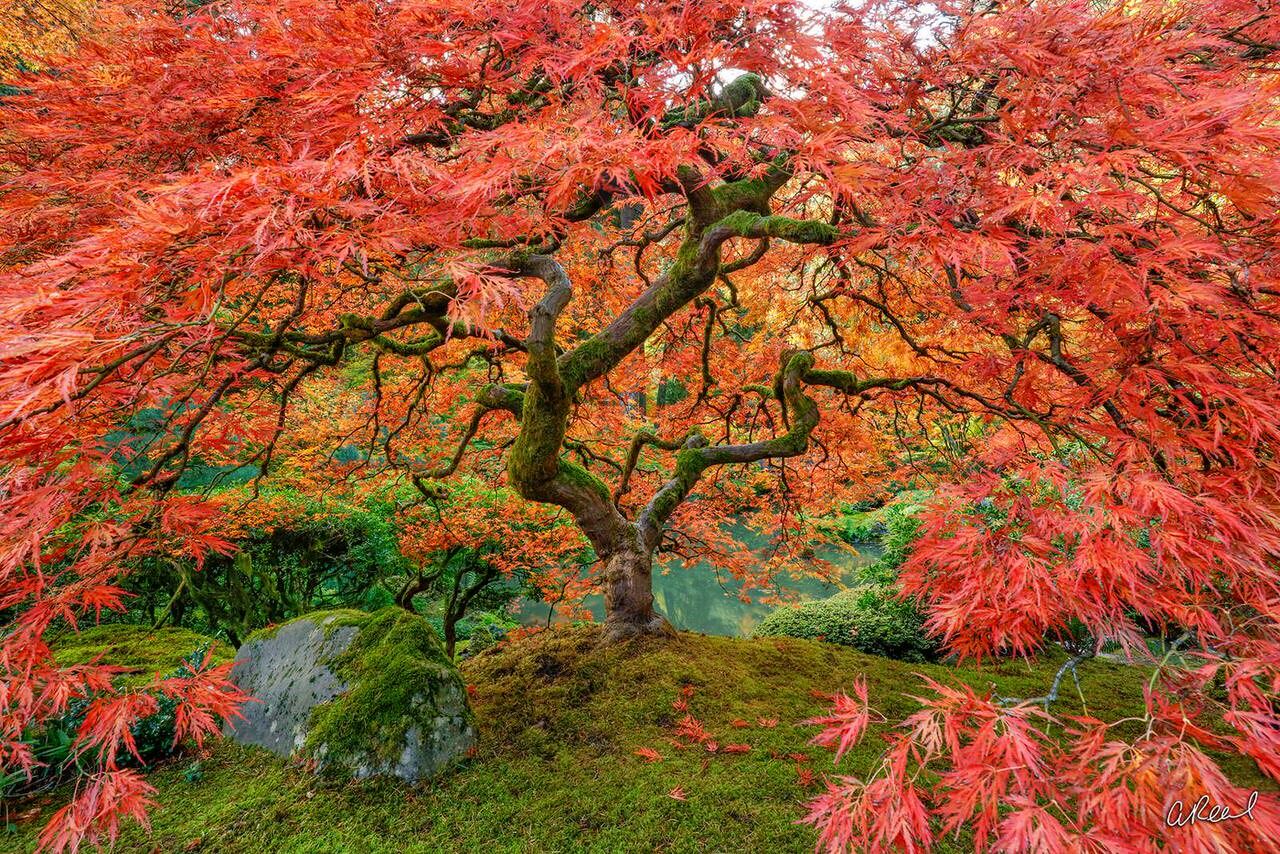
Nebulas of scarlet stars erupt from the twisted branches of an old Japanese maple in a garden in Portland, Oregon. A brilliant flash of fire, the autumn boughs make the surrounding beds of moss seem almost to glow. Fine Art Limited Edition of 200.
Five Common Myths About Photographing The Worlds Favorite Maple Tree
Myth #1 – This Japanese Maple Tree Is Located In A Mysterious Secret Garden Whose Location Is Only Known By Photographer Peter Lik.
This, of course is the most ridiculous and my personal favorite myth of all. Over the years I have been accused of and even have even received hate mail from collectors of Peter Lik’s work who were led to believe that Lik was the first and in some cases only photographer to capture the heavenly beauty of this tree with his camera.
In 2011, an image of this tree titled The Tree of Life by photographer Peter Lik, was awarded 1st place in a photography contest called Windland Smith Rice International Awards and was on exhibition at the Smithsonian in Washington D.C from April – September of 2012. Those of us that lived in Portland had been photographing this tree for years prior to Lik gracing the garden with his “most awarded, most wanted, most full of $%^&* presence.
For anyone still in the dark about the reality here, the tree is located in a public garden in Portland, Oregon and Lik was not the first the photograph it. Also, in case you were wondering, it is also impossible to photograph clouds BEHIND the moon, but I digress.
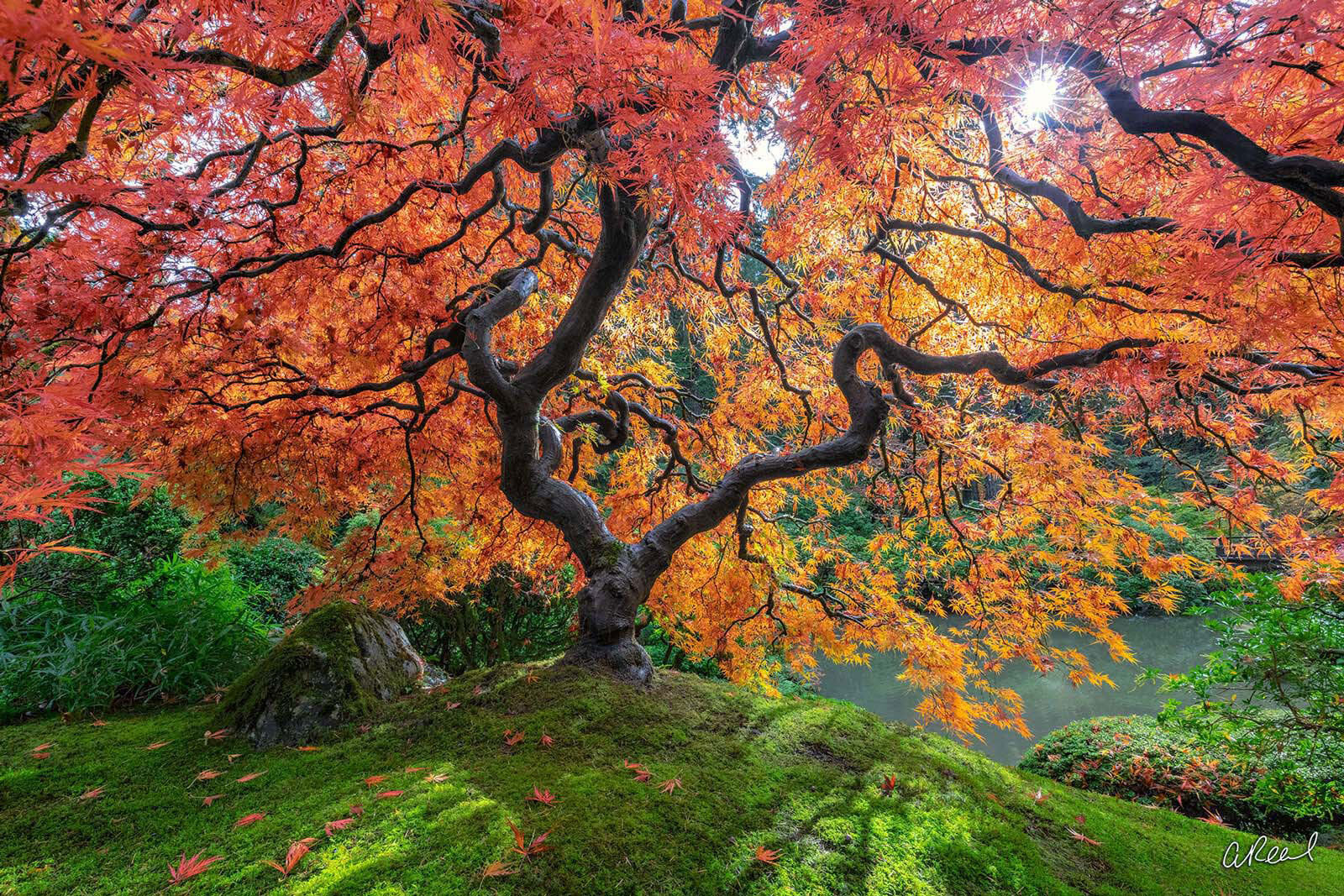
The gnarled branches of a Japanese maple spread forth a flaming crown in a sculpted garden in Portland, Oregon. Beside a tranquil pond, the winding footpaths and soft beds of moss are scattered with the gold and crimson stars from this dazzling display. Fine Art Limited Edition of 100.
Myth #2 – Your Dreams of Climbing This Magical Tree Are Within Reach
Maybe you loved to climb trees when you were a child and you are looking to regain some of the glory of your youth. Maybe you are trying to get closer to God. Maybe you are just a weirdo. Whatever the reason for your quest to conquer the glory of this magical tree, I’m afraid I’m going to have to crush your dreams. The tree is only six feet tall. If you attempt to climb it you will most likely get tackled by a fellow photographer, disemboweled by the ancient Samurai who watch over the garden or be forever haunted by the spirt of Peter Lik. You will most certainly make a fool of yourself.
Myth #3 – You Are Special
I mean, you are special. The odds of you being alive at all are basically zero. When it comes to your desire to photograph this legendary Japanese Maple Tree though, you are going to have to get in line. Literally. Everyone wants to photograph this tree in autumn. Everyone wants it in the best light, hopes for fog, is looking for peak color and thinks their photograph of it is going to be the best photograph ever of Portlands Japanese Maple. Everyone bought the same garden membership you did, thinking that gaining entry two hours before everyone else was going to grant them access to photograph the tree all by themselves. Wearing knee pads and a headlamp, traveling from another country or shooting with your super fancy Phase One camera does not make you special.
In reality I have witnessed lines of up to 40 people waiting to photograph the tree at any one time. I have witnessed fist fights almost break out more than once. Every year I hear the same jokes about how small it is, how someone is going to chop it down, about thinking they were going to climb It and about how special Peter Lik Is. Lol.
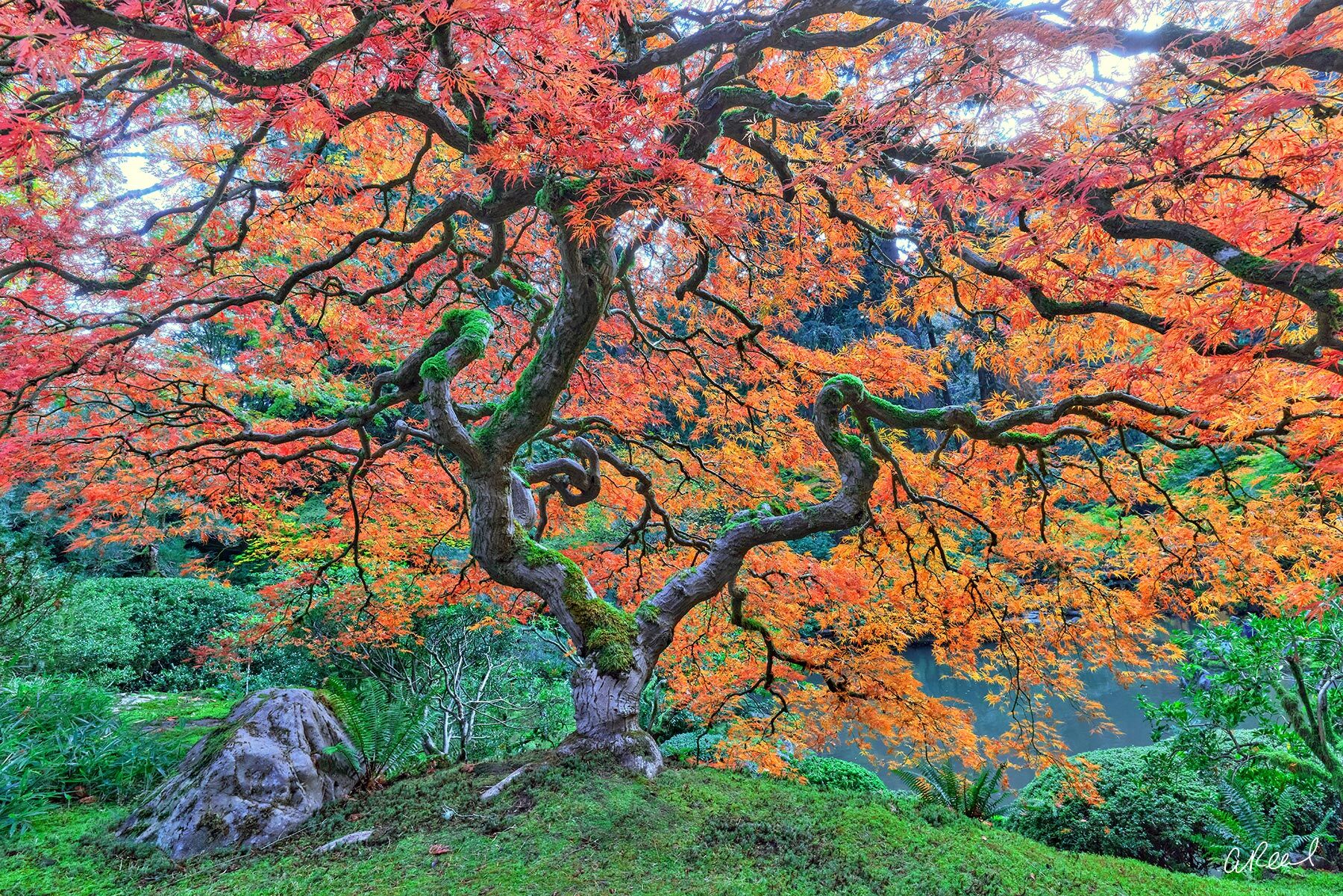
The fiery boughs of a grand Japanese maple fill the skies above a sculpted garden in Portland, Oregon. The enormous canopy shades the beds of jade moss and gently caresses the tranquil waters of a nearby pool. Fine Art Limited Edition of 100.
Myth #4 – It Is The Only Beautiful Japanese Maple In The World
There are at least a thousand different varieties of Japanese maples. Some are quite similar to each other and only of interest to collectors, but there are many unique and special forms of outstanding beauty which are very popular with all gardeners. I bet many of you even have one in your yard like we do. While the Portland Japanese Maple is an extremely beautiful tree, there are literally millions of others across the globe. In fact, if you find yourself in the Pacific Northwest and have an itch to photograph a beautiful maple but don’t want to fight over this one, you can visit this tree inside Seattles Kubota Garden and likely photograph it all by yourself for hours.
Myth #5 – Your Cell Phone Picture Will Make A Great Wall Art Print For Your Home
Over the years I have sold well over one thousand limited edition fine art prints of Portlands Famous Japanese Maple to collectors of my work around the world. While you can certainly capture a beautiful photograph with your cell phone these days and can even print a billboard with the photo you captured with your iPhone, when it comes to a truly spectacular large wall art for your home, there is much more to creating quality artwork for your wall. Bt all means, capture that memory with your smartphone and then give me a call so I can help you get that memory on your wall.
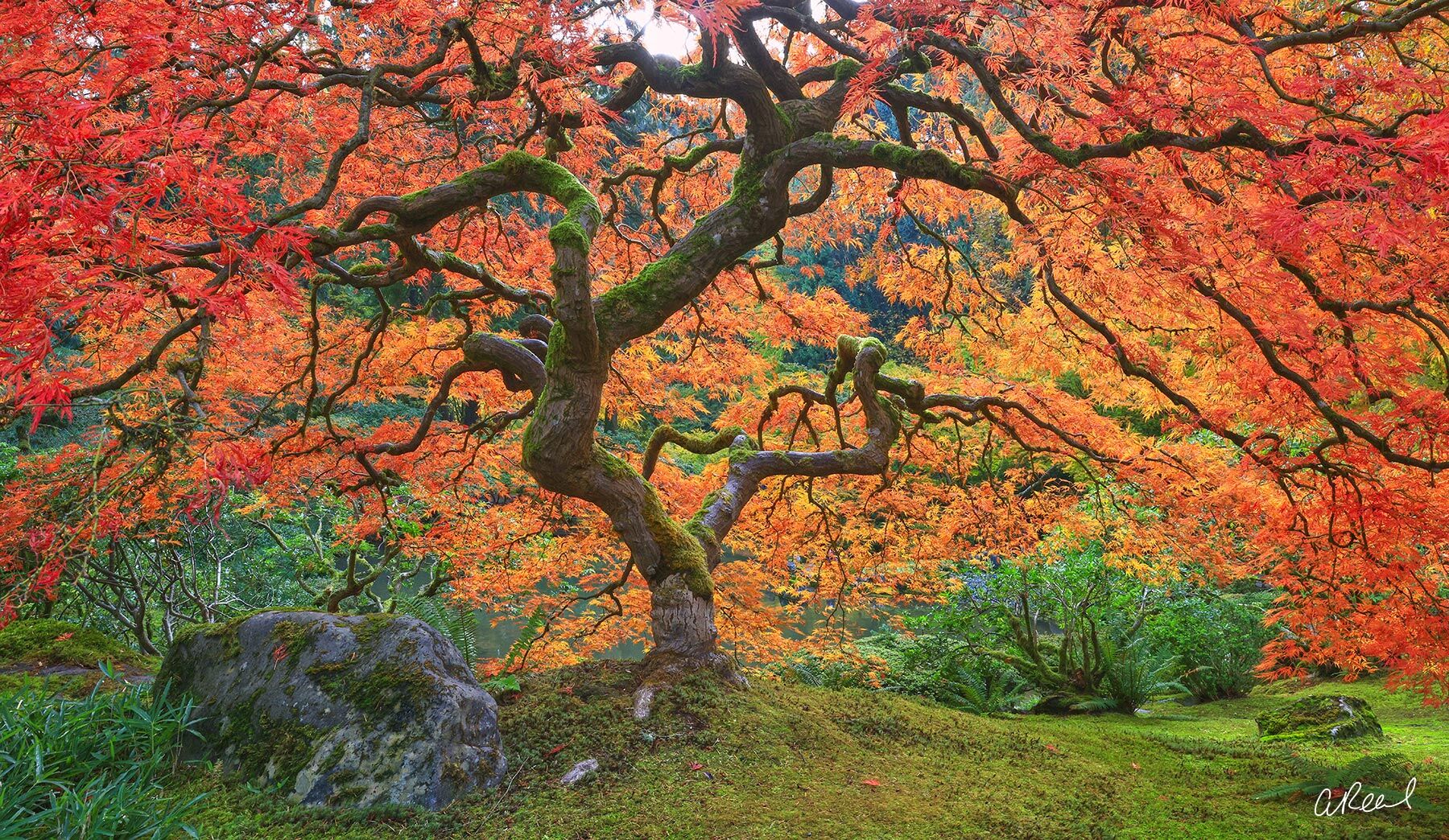
Transform your space with Aaron Reed’s luxury fine art photography print, Embers, from his Panoramic Wall Art collection. Order yours today! Fine Art Limited Edition of 50.
Aaron Reed’s Tips For Photographing Portland’s Japanese Maple
If after reading this blog post, you have your knee pads & headlamp on, your Phase One locked and loaded and your Peter Lik fan club membership badge displayed on a lanyard around your neck, you still want to visit the garden this year, I have a few tips for you.
The colors in the garden are typically best the 3rd – 4th week of October. The tree itself changes from greenish to yellowish and if you are lucky a bright red/orange all in the span of about 5 days. If a strong rain or wind hits Portland once the tree is at its peak, the leaves can completely fall off in a matter of a day or two.
Be patient, take your time photographing the tree, be courteous to other photographers and if you didn’t get the shot you wanted the first time, swing back around again for another go at it. The tree can look very different in various types of light and you can capture some beautiful conditions if you are lucky.
The typical way the tree is photographed is from ground level shooting under the canopy of the tree. You will want a tripod that allows you to get close to the ground, an ultra wide angle lens and will want to use a fast shutter speed to freeze the delicate leaves in the wind.
I hope you have enjoyed this article and have an opportunity to photograph the tree during peak color this year. Just don’t photoshop in a moon with magical space clouds behind it.
Who knows…. maybe I’ll even see you there.
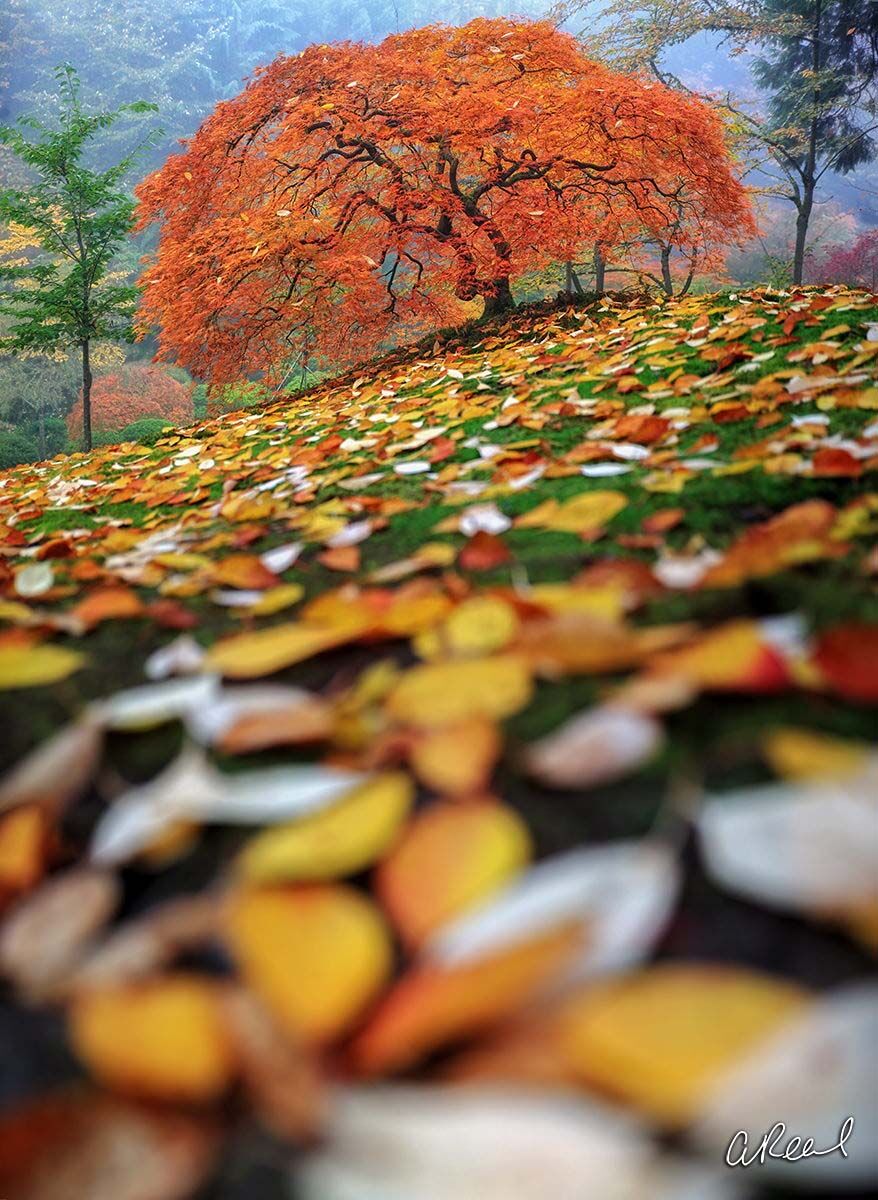
The rounded crown of a Japanese maple sits on the sloping fields of a green hillside like a polished bubble of ancient amber. Across the verdant glade, a blanket of red, yellow, and white leaves forms a dazzling mosaic. Fine Art Limited Edition of 100.
[ad_2]
Source link
